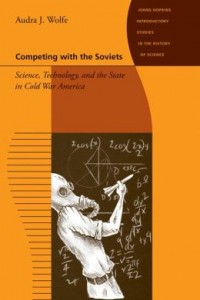Competing with the Soviets: Science, Technology, and the State in Cold War Amercia
by Audra J. Wolfe
176 pages. John Hopkins University Press, 2012.
Those looking for a primer on the history of Cold War science and technology in the United States need look no further than Audra Wolfe’s Competing with the Soviets. The book, which is the latest addition to the Johns Hopkins University Press Introductory Studies in the History of Science, synthesizes an impressive array of recent work to chronicle the history of American science and technology from the beginning of the Cold War to the collapse of the Soviet Union. Wolfe, who has a background in publishing as well as a PhD in the history of science, is a skilled writer. Her book is as engaging as it is informative. The close and contested links between science and the state during the Cold War lie at the center of Wolfe’s narrative. While the text has much to offer, intellectual historians will benefit particularly from one of Wolfe’s key themes: the changing politics of expert knowledge between the beginning of the Cold War and the end of the Vietnam War.
Science and technology were central to political and intellectual life in Cold War America; politics and knowledge—never easily separable—were deeply intertwined. Advances in radar and atomic physics proved crucial to American victory in World War II, and in the years after the armistice, science was a tool for prestige and security. National security agencies, and to a lesser extent domestic agencies, lavished unprecedented amounts support for research and development. But science was also dangerous; it merited secrecy and surveillance. The first three chapters of Competing with the Soviets describe the heady world of risk and reward that gave birth to militarized institutes of atomic physics, the hybrid public-private institutions of the military-industrial complex, and the dominance of big science. Chapter six continues these themes, focusing on the rise of NASA, as well as the fierce competition and tenuous collaboration that marked preparations for the 1957-58 International Geophysical Year.
Of course, there was far more to science in the Cold War than missile gaps and races into space. Experts fanned out into nearly every nook and cranny of the American state. In chapters four and five, Wolfe reveals the extent to which the era’s cult of expertise shaped American approaches to foreign and domestic. She briefly relays the history of American development programs, describing how Americans exported science and technology as a means of winning the hearts and minds of the men and women in newly decolonized regions. In chapter five, which will be of particular interest to intellectual historians, she explains how the state turned to experts, including social scientists, in their quest for solutions to domestic problems like racism, poverty, and budgeting.
Eventually, however, America’s romance with experts turned rocky. When scientific expertise failed to deliver on its promises, criticism of the state’s embrace of scientific solutions to military and domestic problems intensified. Historians interested in the changing status of intellectuals in the 1960s will find Wolfe’s attention to dissent against scientific expertise useful. The early chapters of her narrative demonstrate that dissent against various scientific programs had been common, albeit muted, in the 1950s. Believing that their credibility as critics came from their insider status, dissenters in the 1950s tended to act from within the military-industrial-academic complex. Opponents of nuclear testing, Wolfe explains, “saw no inherent conflict in criticizing nuclear testing while accepting [Atomic Energy Commission] funds” (111). By the late 1960s, however, the public credibility of experts with government ties changed dramatically. American development and counterinsurgency projects had failed to win hearts and minds in Vietnam and elsewhere. At home, social science expertise had failed to live up to its lofty promises of domestic reform. Critics—including scientists, intellectuals, and student activists—challenged the cult of expertise. In a number of cases, the government’s experts were exiled from their homes on university campuses.
By the Reagan era, the American public was less sanguine about the easy equation of scientific knowledge, technological prowess, and state power. Wolfe’s final substantive chapter moves quickly through the 1970s to the 1980s, which she describes as an era of commercialization and privatization. The treatment of the final two decades of the Cold War, condensed largely into a single chapter, is arguably the weakest part of the book. This is not an indictment of the text as much as it is revealing of a weakness in the historiography of science and technology. Most research on Cold War expertise is confined to the period between the end of World War II and the end of the Vietnam War; when it comes to the 1970s and 1980s, there is much less fodder for Wolfe’s synthesis. The text’s treatment of the final two decades of the Cold War as one of commercialization and privatization raises a further problem for historians of the Cold War. In recent years, scholars have questioned the utility of the Cold War as a temporal category. Wolfe argues that “The fundamental characteristic of Cold War science is the central role that the scientific enterprise came to play in the maintenance of the nation-state” (6). For the years between the late 1940s and the late 1960s, this is unquestionably true. But it is less clear that this characterization holds for the 1970s and 1980s. What, then, was “Cold War” about Cold War science in the 1970s and 1980s? Competing with the Soviets points—perhaps unintentionally, but importantly all the same—the way forward for historians of knowledge and technology in the Cold War. When it comes to the 1970s and 1980s, there is much yet to be done.
Joy Rohde is Assistant Professor at the University of Michigan Gerald R. Ford School of Public Policy and the author of Armed with Expertise: The Militarization of American Social Research during the Cold War (Ithaca: Cornell University Press, 2013).


0